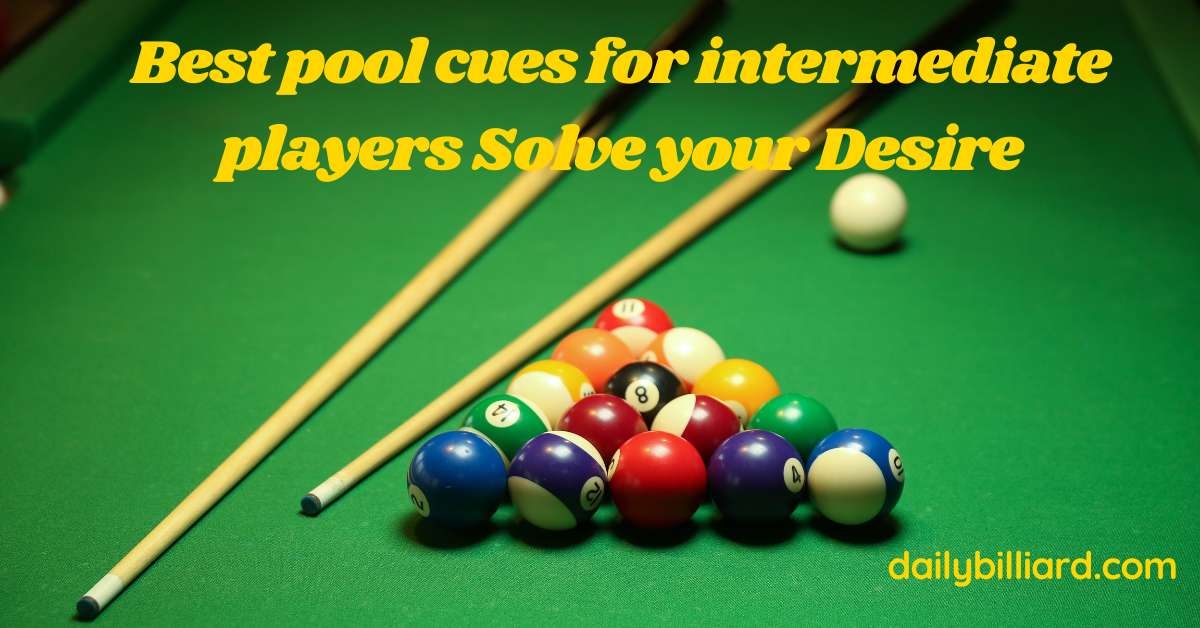Best Pool Cues For Intermediate Players: Elevate Your Game
So, you’ve been playing pool for a while now, and you’re no longer the newbie at the table. But have you thought about upgrading your gear to match your growing skills? Choosing the best pool cues for intermediate players can make all the difference in how you play and how much fun you’re having. Let’s dive into what makes a cue stick perfect for someone at your level.
Here’s the deal—when you’re an intermediate player, you’ve got a solid foundation, but you’re still working on refining your techniques. A good cue stick can help you take your game to the next level. It’s not just about looks or price; it’s about finding a cue that feels right in your hands and helps you execute those tricky shots with precision.
In this guide, we’ll walk you through everything you need to know to pick the right cue for your skill level. From materials and design to price points and brands, we’ve got you covered. So grab a drink, sit back, and let’s get into the nitty-gritty of the best pool cues for intermediate players.
Read also:Pope Francis Apology A Journey Of Forgiveness And Redemption
Table of Contents
- Understanding Your Needs as an Intermediate Player
- Choosing the Right Materials
- Design Features to Look For
- Top Brands for Intermediate Players
- Budget Considerations
- Comparison of Popular Cues
- Maintaining Your Cue Stick
- Tips for Selecting the Perfect Cue
- FAQs About Pool Cues
- Conclusion: Find Your Perfect Stick
Understanding Your Needs as an Intermediate Player
Alright, let’s start with the basics. As an intermediate player, you’ve probably noticed that your game has improved, but you’re still working on consistency and accuracy. This is where your equipment comes into play. A good cue stick can help you nail those long shots, finesse those delicate draw shots, and even pull off some fancy spins.
What makes a cue stick suitable for intermediate players? Well, it’s all about balance, weight, and feel. You want something that gives you enough control without being too heavy or too light. Think of it like driving a car—you want something that responds to your inputs but doesn’t feel like a monster to handle.
And let’s not forget about comfort. If your cue doesn’t feel right in your hand, it’s going to affect your performance. So, take your time to figure out what works best for you. After all, this is the tool you’ll be using to dominate the table.
Key Factors to Consider
- Weight: Intermediate players usually prefer cues in the 19-21 ounce range. It’s heavy enough to give you power but light enough for control.
- Balance: Look for a cue with a balanced feel. It should feel natural when you hold it and not tip too much to one end.
- Tip: The tip of the cue is crucial for spin and control. Leather tips are popular because they offer a good balance of durability and performance.
Choosing the Right Materials
Now that you understand what you need, let’s talk about materials. The material of your cue stick can affect its performance, durability, and even its price. Here’s a quick rundown of the most common materials used in pool cues:
Wood is the classic choice for cue sticks. It offers a natural feel and is often used in high-end cues. Maple and ash are popular choices because they’re strong and lightweight. On the other hand, fiberglass and graphite cues are gaining popularity because they’re more durable and resistant to warping.
But here’s the thing—wood cues tend to have a softer feel, which is great for finesse shots, while synthetic materials like fiberglass and graphite offer more power and consistency. It’s all about finding the right balance for your playing style.
Read also:Xcel Energy Center Renovation A Gamechanger For Minnesotas Heartbeat
Pros and Cons of Different Materials
- Wood: Pros—Natural feel, good for finesse. Cons—Can warp over time, needs more maintenance.
- Fiberglass: Pros—Durable, resistant to warping. Cons—Can feel harsh on delicate shots.
- Graphite: Pros—Super durable, consistent performance. Cons—Lacks the warmth of wood.
Design Features to Look For
Design isn’t just about aesthetics; it’s also about functionality. A well-designed cue stick can enhance your performance and make your game more enjoyable. Here are some design features to consider:
First up, the joint. Most cues have either a two-piece or one-piece design. Two-piece cues are easier to transport, while one-piece cues offer better consistency. If you’re playing at home or in a league, a one-piece might be worth considering. But if you’re traveling to different venues, a two-piece is more practical.
Next, let’s talk about the wrap. Some cues come with a leather wrap, while others have a smooth finish. A wrap can help absorb sweat and provide a better grip, which is crucial during long games. On the flip side, a smooth finish can give you a more natural feel, but it might get slippery if your hands get sweaty.
Key Design Features
- Joint: Two-piece for portability, one-piece for consistency.
- Wrap: Leather for grip, smooth for natural feel.
- Shaft: Tapered shafts are great for beginners, while conical shafts offer more precision.
Top Brands for Intermediate Players
When it comes to pool cues, there are a ton of brands out there. But not all of them are created equal. Here are some of the top brands that cater specifically to intermediate players:
1. Predator: Predator is a household name in the pool world. They’re known for their high-performance cues, especially their Vortex series. These cues are designed to help players improve their accuracy and consistency.
2. Cue: Cue offers a range of cues that are perfect for intermediate players. Their cues are affordable, yet they don’t skimp on quality. If you’re looking for a great value, Cue is a brand to consider.
3. McDermott: McDermott is another big name in the pool cue industry. They offer a wide range of cues, from entry-level to high-end. Their intermediate cues are known for their craftsmanship and attention to detail.
Why These Brands Stand Out
- Predator—Focuses on performance and innovation.
- Cue—Offers great value without compromising quality.
- McDermott—Known for craftsmanship and attention to detail.
Budget Considerations
Let’s talk about the elephant in the room—price. Pool cues can range from $50 to over $1,000, and as an intermediate player, you don’t need to break the bank to get a good stick. Here’s a rough price guide:
Entry-Level Cues: $50-$150. These cues are great for beginners, but they might not have the precision you’re looking for as an intermediate player.
Mid-Range Cues: $150-$400. This is the sweet spot for intermediate players. You’ll get a good balance of quality and performance without spending a fortune.
Premium Cues: $400+. If you’re serious about your game and want the best of the best, these cues are for you. They offer top-notch performance and craftsmanship.
Factors Affecting Price
- Material—Wood cues are generally cheaper than fiberglass or graphite.
- Design—Cues with intricate designs or custom inlays will cost more.
- Brand—Established brands like Predator and McDermott tend to be more expensive.
Comparison of Popular Cues
Now, let’s compare some of the most popular cues for intermediate players. We’ll look at three different options, each with its own strengths and weaknesses:
1. Predator Vortex: This cue is all about performance. It features a low-deflection shaft and a soft leather tip, making it perfect for players who need precision and control.
2. Cue Pro Series: The Cue Pro Series offers great value for the price. It’s made from high-quality materials and comes with a leather wrap for a better grip.
3. McDermott G59: The McDermott G59 is a classic choice for intermediate players. It’s beautifully crafted and offers a great balance of power and control.
Comparison Chart
| Cue | Material | Weight | Price |
|---|---|---|---|
| Predator Vortex | Graphite | 19-21 oz | $300+ |
| Cue Pro Series | Wood | 19-20 oz | $150 |
| McDermott G59 | Wood | 19-21 oz | $350 |
Maintaining Your Cue Stick
Once you’ve found the perfect cue, you’ll want to take good care of it. Proper maintenance can extend the life of your cue and keep it performing at its best. Here are some tips:
First, always store your cue in a case when you’re not using it. This will protect it from dust, moisture, and other elements that can damage it over time. If you have a two-piece cue, make sure to screw it together before each use to ensure a tight fit.
Next, keep your tip in good condition. A worn-out tip can affect your shots, so replace it when necessary. You can also use a tip shaper to maintain the right shape and size.
Essential Maintenance Tips
- Store in a case when not in use.
- Replace the tip when it wears out.
- Use a tip shaper to maintain shape.
Tips for Selecting the Perfect Cue
Here are a few final tips to help you choose the best pool cue for your needs:
First, try before you buy. If possible, visit a local pool hall or retailer and test out a few cues. This will give you a better idea of what feels right in your hands. Also, don’t be afraid to ask for advice from more experienced players or even the staff at the store.
Second, don’t get caught up in the hype. Just because a cue is expensive or has fancy designs doesn’t mean it’s the best choice for you. Focus on what works for your game and your budget.
Final Selection Tips
- Test before you buy.
- Don’t get swayed by price or looks.
- Choose based on performance and comfort.
FAQs About Pool Cues
Q: How often should I replace my cue tip?
A: It depends on how often you play, but a good rule of thumb is to replace your tip every 6-12 months if you play regularly.
Q: Can I use a two-piece cue for league play?
A: Absolutely! Most leagues allow two-piece cues as long as they meet the league’s specifications.
Q: Is a heavier cue better for power shots?
A: Not necessarily. A heavier cue can help with power, but it can also affect your accuracy and control. It’s all about finding the right balance for your game.
Conclusion: Find Your Perfect Stick
Choosing the best pool cues for intermediate players
Article Recommendations


